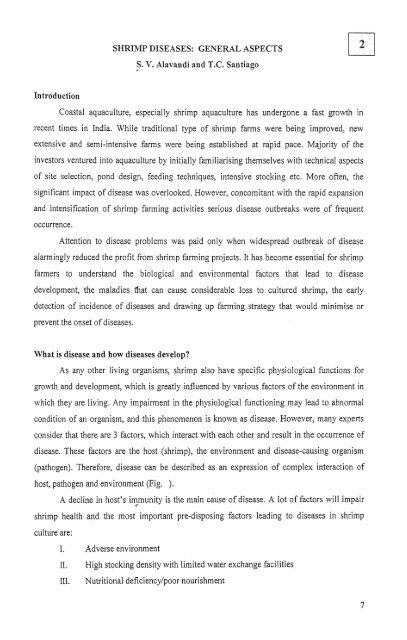, Diagnosis an-&& of Shrimp Diseases - Central Institute of ...
, Diagnosis an-&& of Shrimp Diseases - Central Institute of ...
, Diagnosis an-&& of Shrimp Diseases - Central Institute of ...
- No tags were found...
You also want an ePaper? Increase the reach of your titles
YUMPU automatically turns print PDFs into web optimized ePapers that Google loves.
SI-IRXMP DISEASES: GENEIL4L ASPECTSS. V. Alav<strong>an</strong>di <strong>an</strong>d T.C. S<strong>an</strong>tiagoIntroductionCoastal aquaculture, especially shrimp aquaculture has undergone a fast growth inrecent times in India. While traditional type <strong>of</strong> shrimp farms were being improved, newextensive <strong>an</strong>d semi-intensive farms were being established at rapid pace. Majority <strong>of</strong> theinvestors ventured into aquaculture by initially familiarising themselves with technical aspects<strong>of</strong> site selection, pond design, feeding techniques, intensive stocking etc. More <strong>of</strong>ten, thesignific<strong>an</strong>t impact <strong>of</strong> disease was overlooked. However, concomit<strong>an</strong>t with the rapid exp<strong>an</strong>sion<strong>an</strong>d intensification <strong>of</strong> shrimp farining activities serious disease outbreaks were <strong>of</strong> frequentoccurrence.Attention to disease problems was paid only when widespread outbreak <strong>of</strong> diseasealarmingly reduced the pr<strong>of</strong>it from shrimp farming projects. It has become essential for shrimpfarmers to underst<strong>an</strong>d the biological <strong>an</strong>d environmental factors that lead to diseasedevelopment, the maladies fiat c<strong>an</strong> cause considerable loss to cultured shrimp, the earlydetection <strong>of</strong> incidence <strong>of</strong> diseases <strong>an</strong>d drawing up farming strategy that would minimise orprevent the onset <strong>of</strong> diseases.What is disease <strong>an</strong>d how diseases develop?As <strong>an</strong>y other living org<strong>an</strong>isms, shrimp also have specific physiological functions forgrowth <strong>an</strong>d development, which is greatly influenced by various factors <strong>of</strong> the environment inwhich they are living. Any impairment in the physiological functioning may lead to abnormalcondition <strong>of</strong> <strong>an</strong> org<strong>an</strong>ism, <strong>an</strong>d this phenomenon is known as disease. However, m<strong>an</strong>y expertsconsider that there are 3 factors, which interact with each other <strong>an</strong>d result in the occurrence <strong>of</strong>disease. These factors are the host (shrimp), the environment <strong>an</strong>d disease-causing org<strong>an</strong>ism(pathogen). Therefore, disease c<strong>an</strong> be described as <strong>an</strong> expression <strong>of</strong> complex interaction <strong>of</strong>host, pathogen <strong>an</strong>d environment (Fig. ).A decline in llost's immunity is the main cause <strong>of</strong> disease. A lot <strong>of</strong> factors will impairshrimp health <strong>an</strong>d the most import<strong>an</strong>t pre-disposing factors leading to diseases in shrimpculture are:I. Adverse environment11. High stoclting density with limited water exch<strong>an</strong>ge facilities111. Nutritional deficiencyipoor nourishment
















